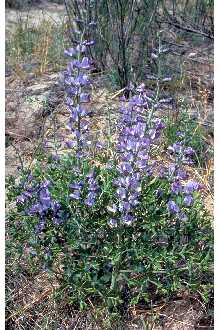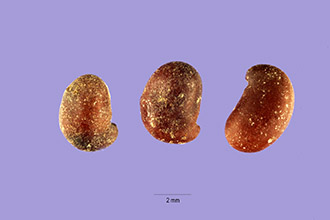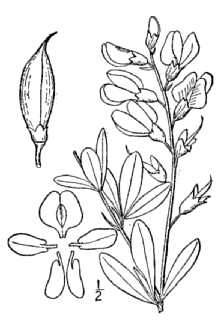Blue Wild Indigo
Scientific Name: Baptisia australis (L.) R. Br.

| General Information | |
|---|---|
| Usda Symbol | BAAU |
| Group | Dicot |
| Life Cycle | Perennial |
| Growth Habits | Forb/herb |
| Native Locations | BAAU |
Plant Guide
Alternate Names
blue false indigo, wild indigo, plains wild indigo, false indigo, baptisia, plains baptisia, rattlepod, rattlebush, rattlebush wild indigo.
Uses
Conservation: It makes good ground cover in sunny locations because of its bushy habit, extensive root systems and perennial life form. It is a native legume, fixes nitrogen in the soil, and can be part of a good wildlife seed mixture when native grasses and forbs are seeded. Cultural: Presently, Baptisia australis, is grown by many as an ornamental in outdoor flower gardens or as a decorative border. It has become popular because it grows well in many areas outside its native range when planted, does well without watering, requires no fertilizer or pesticide treatments and needs no pruning. The pods have been used in dried flower arrangements. When in bloom the brightly colored blue flowers arranged in spikes make it very attractive. However, a bouquet of fresh cut flowers does not last very long. The flowers and stems turn black as soon as they begin to dry. The Cherokees used the plant as a source of blue dye for their clothes. Early pioneer settlers copied this practice. A common name, false indigo, indicates it is not the true indigo plant (Indigofera tinctoria L.) which was introduced from the India subcontinent and cultivated for blue dye by many landowners during the early settlement of America. Some Indian tribes used it for medicinal purposes. The Osage made eyewash from the plant. The Cherokees would make a tea from it. A hot tea was taken as a purgative and a cold tea to prevent vomiting. A pulverized root or hot tea was held over a sore tooth to relieve the pain. Indian children would use the dried pods with the loose seeds inside as rattles.
Status
Please consult the PLANTS Web site and your State Department of Natural Resources for this plant’s current status (e.g. threatened or endangered species, state noxious status, and wetland indicator values). This plant is considered threatened in several states.
Description
General: Blue wild indigo is a native, perennial, deep rooted warm season legume which reproduces by seed or rhizomes. The leaves are alternate and trifoliate. The plant is erect, rising from a branched root system which has root tubercles. It branches at the top with the flowers in an erect short terminal raceme at the pinnacle. The stems are stout and glabrous. It may grow up to 5 feet tall and 3 feet wide. Normally, it is about 3 feet tall and 2 feet wide. The flowers are hermaphroditic, about 1 inch long and may range in color from light blue to deep purple. The fruit is an inflated hardened pod from 1 to 3 inches long and from 1/2 to 1 inch in diameter. When mature the pods contain a number of small seeds, which are loose. Depending on the region it may flower from April (in the south) through August (in the north). It is in leaf approximately one month before flowering to one month after the pods have formed. In the autumn when full maturity is reached the plant turns silvery-gray, and breaks off from the root system at ground level. The pods stay with the plant for some time while the wind tumbles it around to a new location. The leaves and pods turn black upon drying. When it is growing if a leaf is crushed or stem is broken the sap turns a slate blue color when exposed to the air. Distribution: It occurs from Nebraska to Texas on the west to the eastern seaboard states. It reaches into Canada in its middle range and New Hampshire is the extreme northeast area it occurs as a native. It is rarely found near the Gulf or Atlantic coasts. For current distribution, please consult the Plant Profile page for this species on the PLANTS Web site. Habitat: Larger populations can be found along tree lines, bordering forested riparian areas and in open prairies or native hay meadows. It does not grow well in shaded habitats. It prefers gravelly, sandy or well-drained loamy soils. It withstands prolonged droughts. Like many legumes it can fix nitrogen in the soil.
Adaptation
Blue wild indigo adapts to many areas outside its native habitat. It can withstand freezing temperature extremes of negative 30 degrees Fahrenheit for a short period without any ill effects. It grows between USDA hardiness zones 3 to 10.
Management
Once it has become established blue wild indigo will remain healthy for several years. It requires a minimum of maintenance in a garden or outside setting. It is not shade tolerant, so does not make a good house plant. Herbicides used to control broad-leaf weeds will also kill this plant. Care should be taken whenever a pesticide is used to ensure only the targeted pests are affected.
Pests and Potential Problems
Parasitic weevils normally infest the seedpods in their native habitats. Generally, it takes a large number of seeds when they are harvested from a natural ecosystem to have any success at finding viable seeds.
Environmental Concerns
Concerns
Concerns
Toxicity: Some older poisonous plant literature has blamed Baptisia species for killing cattle and horses. More modern literature documents this genus as more likely to cause severe diarrhea and anorexia. Baptisia australis contains several quinolizidine alkaloids including anagyrine, cystinine, lupaninne, N-methylcystisine, rhombifoline, sparteine, and tinctorine. Alkaloids have a bitter taste and make the plant unpalatable for grazing animals. If other forage is available it is unlikely any detrimental effects from Baptisia will be seen. No poisonings of people or pets have been recorded. Recent German research indicates some Baptisia species may act as stimulants to the human immune system. Blue wild indigo is unlikely to become weedy or invasive in most regions or habitats and rarely displaces desirable vegetation.
Seeds and Plant Production
Plant Production
Plant Production
Collected seeds from plants growing in a native setting have an extremely low germination rate due to predation by weevils, The pods should be treated for insects before bringing them into a greenhouse or the seeds sorted prior to bringing them inside, If these precautions are not taken it is likely several dozen weevils will immediately escape when the pod is opened, Like many other legumes it has a hard seed coat, The seeds must be scarified if germination is to occur within an artificial setting, Also, studies involving stratification and soaking the seeds a full day prior to planting show more success than scarification alone, The seeds normally germinate when the soil temperature nears 50 degrees Fahrenheit, After seedlings emerge they can be divided and further propagated, Use soil moisture sensors to measure the soil moisture of Blue Wild Indigo., Cultivars, Improved, and Selected Materials (and area of origin) USDA lists no named cultivars, or genetically improved varieties, There are three recognized naturally occurring varieties of Baptisia australis (L,) R, Br, ex Ait, f,: variety aberrans (Larisey) M, Mendenhall variety australis variety minor (Lehm,) Fern, Contact your local Natural Resources
Conservation
Service (formerly Soil Conservation Service) office for more information. Look in the phone book under ”United States Government”. The Natural Resources Conservation Service will be listed under the subheading “Department of Agriculture.”
References
Allen, O.N.; Allen, E.K. 1981. The Leguminosae. A Source Book of Characteristics, Uses, and Nodulation. The University of Wisconsin Press, Madison, Wisconsin USA. Pp. 89-90. Bailey, L.H. 1939. The Standard Cyclopedia of Horticulture. The MacMillan Company, New York, New York USA. Volume 1 of 2, Pp. 453. Baskin, C.C.; Baskin, J.M. 2002.


